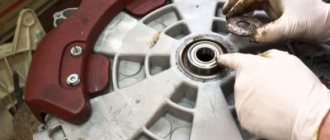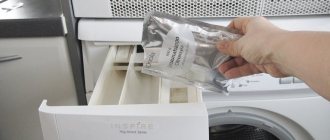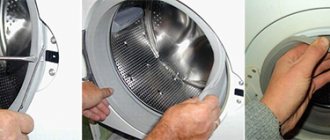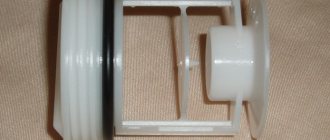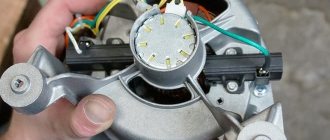During the operation of the washing machine, various technical problems may occur. Among the malfunctions of the home assistant, one can note the appearance of a hum during washing and strong vibration. The cause of serious malfunctions in the operation of a household appliance is defects in the drum. It is possible that it jams and does not spin if foreign objects get into the device components. Replacement of worn-out parts and structural elements is impossible without disassembling the device. To troubleshoot problems, you can use the services of professional technicians and try to solve the problem yourself. Let's look at how to disassemble a washing machine drum yourself and what you will need for this.
Causes of breakdowns
The situation when, after starting the washing machine, after some time it stopped rotating and the drum jammed, is familiar to many owners of household appliances. The reasons for the failure of a household unit may be related to mechanical damage, wear of parts, structural components, malfunctions of electronics, and problems with wiring. To eliminate the malfunction, it is very important to establish the root cause of what exactly caused the malfunction of the household device, and for this the device will have to be disassembled.
Reasons that led to drum failure:
- ingress of foreign objects into components, structural parts, drums - buttons, coins, underwires from women's bras. The drum is jammed, does not spin, and turns with difficulty. To establish the causes of malfunctions, it is necessary to dismantle the heating element, after which third-party objects can be removed;
- jamming, wear of bearings, flanges, seals. The problem arises with frequent use of household cleaning products. The cuff wears out over time and water leaks into the bearings. The bearings fall apart, the drum shaft jams, and the drum does not spin. It is best to entrust replacement to washing machine service specialists;
- broken drive belt, which is equipped with machines with commutator motors. The problem occurs when automatic washing machines are idle for a long time. The belt material loses its properties, cracks appear on its surface, which lead to rupture during operation of the machine. In this case, the most vulnerable spot is the electric motor pulley. Before replacing the belt, remove the back cover of the unit and examine the markings on its outer surface;
- The drum drive motor is not functioning. During operation, the operation of the motor wears off the material of the brushes, and an unpleasant specific smell appears when the washing machine operates. If the brush life is exhausted, the drum stops rotating. Before installing new brushes of the appropriate size, the commutator is cleaned;
- malfunction of the electronic programmer module, which, depending on the model modification, is responsible for the water supply valve, operation of the drain pump, collector motor, thermistor, timer. In fact, the electronic module is responsible for the performance of the main parts and engine components of washing machines.
The drum may jam and not spin if the tachometer fails, the electrical wiring is damaged, or the capacitor burns out. In this case, it is necessary to carry out serious diagnostics. The reason why the drum does not spin may be overload with laundry or clogged filter. All of the above reasons require troubleshooting, so you cannot do without disassembling the washing machine and removing the drum.
Inoperative state of the electronic module
Foreign object in drum
Belt break
Bearing wear
Drum motor malfunction
Is it possible to solve the problem
If something gets into the drum assembly, it can cause the washing machine to stop and break down.
To remove debris, you must disassemble the unit. However, it is worth considering that there are some nuances. The drum should be removed very carefully so as not to touch other parts of the device. As a rule, such repairs are carried out by professional craftsmen. In order not to make unnecessary efforts, it is advisable to observe the equipment and understand what exactly is the deterioration in performance. If the overall quality of the wash has dropped, an uncharacteristic noise appears during the spin cycle, and the laundry remains wet after the spin procedure, the problem most likely should be looked for in the pump.
The same unpleasant phenomena are caused by clogged communication hoses. It is better to approach all these components from the front of the unit or from below. If foam comes out of the machine during operation, you need to stop washing, set the “Drain without spin” program and wait until the device completes all the necessary actions and opens the door.
Then you should remove the laundry, manually clear the foam from the inside and start the wash again without spinning. If this is not done, foam will penetrate into the engine or onto the control board, and repairing these components will cost the owners a substantial amount.
The reason for the appearance of abundant foam in the washing machine may not be a breakdown or malfunction of the unit itself, but the use of hand washing powder (it does not contain defoamers) or a significant excess of the standard dose of detergent
If the device does not gain temperature and does not warm up the water, it is most likely that the working heating element has failed. Its location is indicated in the accompanying technical documentation. It is usually located at the rear, but in some models, depending on the manufacturer and internal design features, it may be located in the front.
It may have built up scale as a result of using hard water and will need to be cleaned. Or, if the element burns out, you will need to replace it with a new heating element. The replacement process is described in detail in our recommended article.
If the machine takes a long time to wash, you should look for a fault in the electronics. It would be a good idea to check the functionality of the water temperature sensor and other controls. The same problem can occur due to an incorrectly placed drain hose.
A pressure switch or pump is responsible for uniform and rapid drainage of liquid from the washing container. Slowly pouring water clearly indicates that these elements have lost their functionality due to breakdown or operational wear.
To repair them or replace them with new ones, you will have to dismantle the side wall and penetrate into the upper part located behind the rear panel.
When failures occur in the drum or bearings, you will have to completely disassemble the device, identify the problem, carry out repairs, and then assemble the machine and start it up. If washing proceeds as usual, then operation can be continued.
This is just a short list of the main breakdowns identified in the machines. It is relevant for all household washing equipment, regardless of the brand and design features of each individual device.
Problems with electronics and software control are more complex problems and require professional intervention. To eliminate breakdowns of this level, regardless of whether the equipment is still under warranty or not, it is better to contact a specialized service center.
The certified technicians working there will carry out diagnostics, quickly identify the source of the malfunction and repair the damaged electronic unit or replace it with a new one.
Tools for work
Before carrying out work, having established the cause of the malfunction, you need to prepare the necessary equipment, tools, and purchase failed elements and parts.
To repair a washing machine you will need:
- screwdriver;
- set of hexagons;
- screwdrivers with a cross-shaped, slotted nozzle;
- open-end wrenches;
- set of sockets, ratchet;
- hammer, pliers.
What may be required for work
In order not to be distracted from the work process, it is worth preparing the necessary tools and purchasing replacement parts in advance. The complexity of disassembly depends on the design of the washing machine model.
Before carrying out repairs, read the operating instructions, familiarize yourself with the technical characteristics, disassembly diagram of the model, watch training videos on disassembling the tank.
How to remove a drum on a washing machine
If it is not possible to take the washing machine to a service center or repair shop, then you can try to remove the washing machine drum yourself. This will require tools that any man has. An electric screwdriver, wire cutters with narrow noses, asterisks in a set, pliers, a Phillips and flathead screwdriver, sometimes you may need hex keys, a ratchet with socket heads and a hammer.
Some models of washing machines are very easy and simple to disassemble, but some will require some thought. If you need to replace any components, you need to purchase them in advance.
There are only two types of loading laundry into a washing machine. Front loading, that is, the drum is located horizontally and in the wall of the machine. Vertical loading, when laundry is loaded from above. Since the types are different, such drums are removed in different ways.
Drum repair
If the drum does not spin, it must be disassembled. Remove the back cover by unscrewing the screws on the rear panel, disconnect the wiring, pressure switch hoses, the hose from the powder receiver, and the drain pipe. To disconnect the wires, unscrew the clamps.
If the tank is collapsible, simply unclench the brackets connecting the two halves of the tank
Disconnect the heating element
Disconnect the wires from the heating elements. If electrical wiring is connected to the tank, it is recommended to disconnect and remove it so that it does not interfere with the process of disassembling the drum. There are counterweights installed at the bottom and top of the tank, so to make the structure lighter, they are also removed. Remove the drum from the springs by unscrewing the fixing shock absorbers with a wrench. Since the tank is removed along with the engine, it must be disconnected by removing the belt. Now you can begin to disassemble the washing machine drum and replace the failed elements.
Washing machine pulley bolt
The design of the loading tank consists of two parts (halves) screwed together with bolts. In some models, manufacturers install soldered drums. To dismantle the forecastles, unscrew the connecting hardware. When removing, evaluate the condition of the seals and bearings. Wipe the drum bushing from water and old lubricant.
Disassembly begins with removing the pulley secured to the drum shaft of the machine with a bolt. Fixing the pulley with a wooden block, unscrew the bolt. If the bolt is difficult to unscrew, you can heat it a little with a gas heating pad. Carefully pull off the pulley, unscrewing it in different directions.
We knock out the shaft with a wooden block so that it is flush with the bearing. The drum should rest against the front of the tank. We unscrew the tank in a circle, removing the bolts, latches, and clamping brackets. Divide it into halves. Remove the tub from the washing machine.
Use a wooden block to jam the drum pulley
Having pryed the oil seal, remove it with pliers and a flat screwdriver. If necessary, replace it with a new one. Using a hammer, a punch, the cross-sectional diameter of which must match the size of the bearing, carefully knock out the bearings, trying not to damage the edges or walls of the hole. The new bearing is pressed into place using a punch and screw press. If the crosspiece is damaged or worn out, replace it with a new part.
The washing machine tank consists of two parts
Step-by-step disassembly instructions
Changing a washing drum is not easy. To do this, you need to disassemble the entire household appliance. Moreover, the dismantling process depends on the type of unit (vertical or horizontal loading). But first you need to:
- de-energize the device;
- take the laundry out of the machine;
- remove the inlet hose.
In a machine in which things are loaded horizontally, the drum is attached to the rear wall. Therefore, disassembly involves the following steps:
- The first step is to remove the screws holding the back wall.
- Then remove the cover along with the powder tray and control panel.
- Pull out the hatch cuffs.
- Remove the wiring and unscrew the bolt holding the drum.
Experts do not recommend completely removing the control panel because it can be easily damaged. If you still have to remove this part, then it is best to photograph the location of the wires at the dismantling stage. This will make it easier to install the spare part in place.
In a top-loading machine, the drum is attached to the walls on both sides. This complicates the task a little, but you can still dismantle the device if you unscrew the screws on the front and end walls, remove the panel on the side, disconnect all the wiring and remove the remaining screws.
Then it remains to remove the second side wall in the same way, remove the screw securing it to the shaft and remove the drum.
It is recommended to capture everything that is done during the disassembly process on camera for ease of reassembly.
If you have little or no experience in repairing washing machines, you should know how to correctly carry out this or that procedure.
For example, before removing the drum, you need to get rid of the fasteners. To do this, you need to know their location and carefully unscrew them.
So, the back panel is removed by unscrewing the screws holding it, and to separate the drive belt, carefully turn the pulley clockwise.
The screws that secure the dashboard are located in the powder tray.
To release the top of the tank, you need to remove:
- pipe branch;
- counterweight;
- water intake valve;
- pressure switch
The heater, motor, pipe, counterweight and shock absorbers are removed below. It should be taken into account that the heating element of most devices is located under the tank.
Before removing the engine, it is freed from the power and grounding chips, and only then the fastening bolts are removed.
The drum can only be removed from the half-disassembled tank after removing the pulley. But the bolt that held the pulley needs to be put back in place. Only then will it be possible to knock out the drum with a hammer.
Dismantling a welded tank
Some manufacturers, in order to reduce the cost of the model, install a soldered tank. If the drum does not spin, it is jammed, in case of malfunctions of its components or parts, a new tank will need to be installed.
The disassembly process is as follows:
- remove the tank from the washing machine;
- determine the location of the welded connecting seam. Every four to five centimeters, drill shallow holes with a drill using 3-4 mm drills;
- we cut the drum along the seam with a saw, a hacksaw for cutting metal, or a jigsaw;
- We carefully cut off the front part of the tank, where the drum is located. The rear part remains in the tank;
- turning over the main part of the tank, we find the place of its connection with the drum. Fixation is carried out on the wheel, which is dismantled with a flat screwdriver.
We take out the tank
Finding the seam location
If the tank is not collapsible, you will have to cut it
As you can see, the technology of disassembling the drum is a rather labor-intensive, painstaking, responsible process that requires technical knowledge and experience. The work must be done in a consistent manner. Without confidence in your abilities, entrust the repair of your washing machine to professional craftsmen and do not try to disassemble the equipment yourself.
To prevent damage to the washing machine, before starting the unit, check your clothing pockets, use special bags for washing small items, do not exceed the amount of detergent, and do not put a lot of laundry in one wash cycle.
If any extraneous noises, creaks, or sounds occur, if you notice that the drum is spinning slowly, or if other faults are detected, call a washing machine repair specialist.
Connecting the halves of the tank
After the tank is cut, you can proceed to replacing the bearings, installing a new oil seal, repairing the cross, etc. At the end of the work, another important task remains - to assemble the monolithic tank of the Indesit washing machine. To glue the tank, you need to prepare:
- silicone moisture-resistant sealant;
- two clamps for securing the halves (for example, you can use a regular awl);
- screws with nuts.
The algorithm of actions will be as follows:
- degrease the seam on both halves of the tank;
- Apply moisture-resistant sealant to the connecting seam.
The surface must be lubricated thoroughly, without missing the slightest area. To glue the tank, you need to choose a sealant that can withstand temperature changes, pressure, vibration, and exposure to water.
- connect both parts of the tank. When placing the lid on the base, press it down lightly;
- To prevent the halves from slipping during further actions, fix them. The clamps (in our case, awls) are installed in two places on the sides of the tank, in the holes located on the welding seam;
- Take the screws and insert them into the holes around the perimeter of the seam. Twist them. Thus, the two halves of the tank will be securely fastened together.
Leave the tank for a few minutes until the sealant is completely dry. Next, you need to attach the drain hose to the tank. The hole for it is also treated with sealant, after which a hose is inserted there. Afterwards, a counterweight, shock absorbers, etc. are attached to the tank. These works no longer relate to the topic under consideration, so we will not focus on them.
As you can see, you can disassemble and solder back the tank of an Indesit washing machine in a couple of hours. The work will proceed especially quickly if you choose a non-standard cutting method. If you cut the tank with a jigsaw, you can save not only time, but also your energy. Using a hacksaw, you will have to press on the seam, constantly work with your hand, but in our case you just need to hold the jigsaw tightly, direct the movement of the file and make sure that it does not go too deep.
Interesting:
- DIY washing machine tank repair
- Which washing machines have a collapsible tank?
- Reviews of Indesit washing machines
- Dimensions of the Indesit washing machine
- Which is better: LG or Indesit washing machine?
- Which Bosch washing machine is better to buy?
- Share your opinion - leave a comment
Replacing an element
Once the drum is removed, you can begin installing the new part.
Algorithm of actions:
Using a metal rod, gently tapping, we knock out the bearings from the outside and inside of the tank.
After installing the new drum, the two halves of the tank are connected (the edges are pre-lubricated with sealant) and tightened with fixing bolts and nuts.
Preparing for disassembly
To disassemble the Atlant washing machine, you first need to prepare the tools. The user will need:
- Set of flat and Phillips screwdrivers.
- Pliers.
- Set of wrenches.
- Set of socket heads.
- Hammer.
After disassembly, in the process of diagnosing equipment and replacing parts, other tools, materials and devices may be required - a multimeter, a screwdriver, WD-40, rags, etc.
Before disassembling the Atlant washing machine, the equipment must be disconnected from the network, water supply and sewerage and moved to a spacious place for more comfortable work.
Reassembly and inspection
The reverse assembly process follows the following algorithm:
- we mount the tank in its original place (suspended on springs);
- install shock absorbers (for this work it is convenient to place the machine on its side);
- connect the drain hose;
- we connect the wiring to the heating element and the engine (it is convenient to carry out the work when the machine is positioned vertically);
- install the drum cuff and secure it with a clamp;
- connect the water intake, control panel;
- install a counterweight;
- fix the lid of the washing machine;
- We connect the washing machine to the sewer.
You can check the operation of a repaired washing machine only during the washing process. The machine is plugged in, select the required program on the control panel, and press the “start” button.


